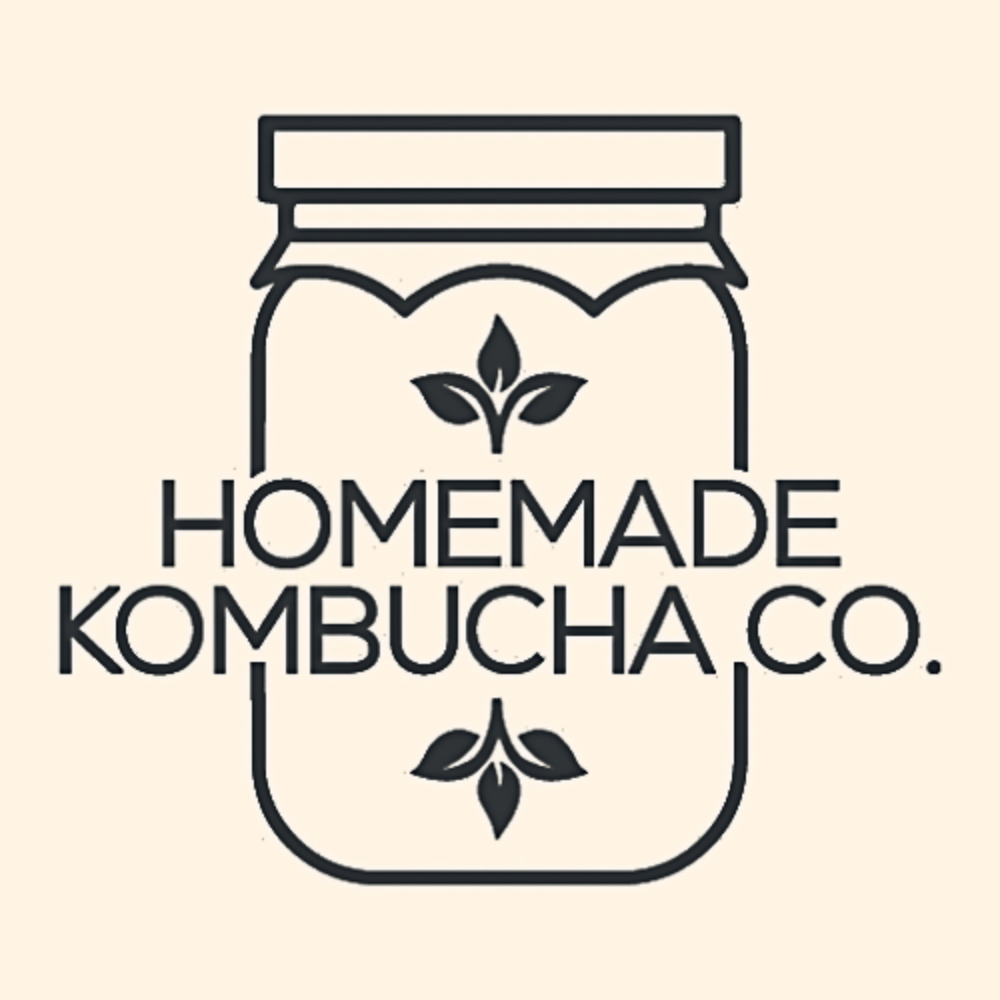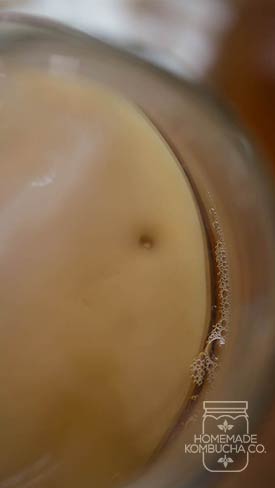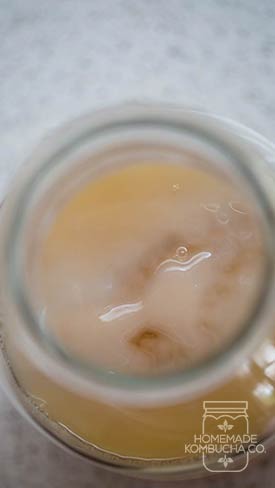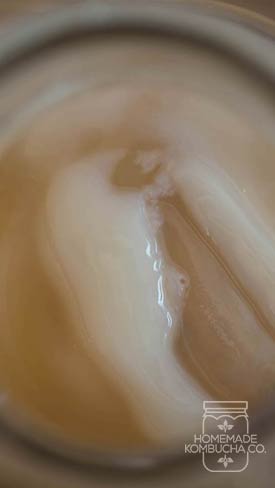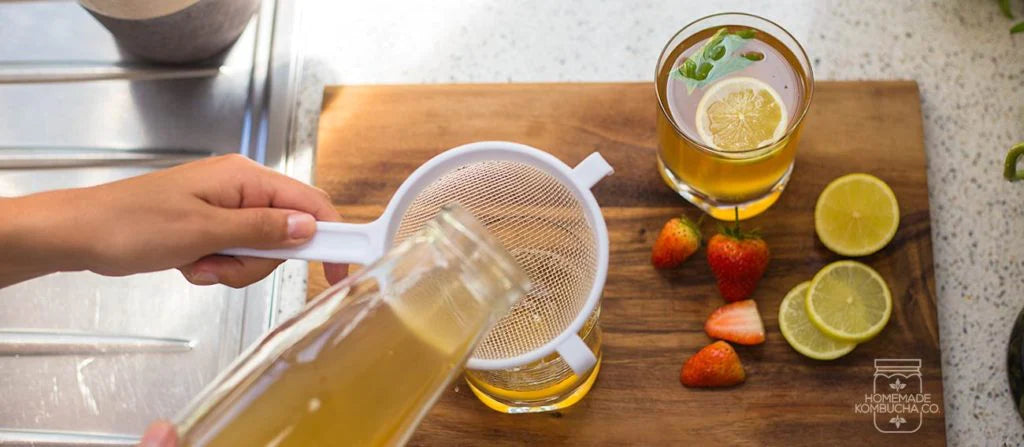Blog
How to make a kombucha drink?
Everything you need to know when brewing your own organic homemade kombucha! Our kombucha SCOBYs are made using certified organic products and a careful brewing procedure to ensure a healthy bacteria and yeast symbiosis, free of metal, plastic and chemical contaminants.
We have all the tips & tricks + information about kombucha & kombucha SCOBYs.
If you have any questions about kombucha and how to make kombucha, check this out!
Learn how to make your kombucha recipe with your homemade kombucha scoby
How to make Homemade Kombucha at home
Kombucha ingredients
1. Homemade Kombucha Co. organic kombucha SCOBY.
2. Reverse osmosis filtered water
3. Sugar.
4. Organic black or green tea.
Kombucha equipment required
Equipment for making kombucha tea:
- Large saucepan.
- Long handled wooden or silicone tongs and spoons.
- Measuring cups.
The kombucha brewing kit:
- Large brewing glass jar.
- Fine muslin cloth and rubber band.
Don't forget to check out what other kombucha supplies could be useful for your kombucha brew!
The kombucha brewing space
A clean, dark cupboard that allows enough oxygen to flow through.
Be sure to read The Brewing Environment in our Other Tips & Tricks further down the page!
Sterilise your kombucha brewing jar
1. Use distilled white vinegar and a clean cloth to scrub your kombucha jar.
2. Rinse, drain and allow to drip dry by placing your kombucha brewing jar upside down.
3. Note that boiling water will sterilise the kombucha jar but can easily crack the glass with thermal shock. We do not recommend this method. If you want to use boiling water, please use warm water first to reduce the thermal shock.
Kombucha measurements & ratios
1L Jar - Kombucha Tea Recipe:
- Filtered water: 2-3 cups.
- Sugar: 1/4 cup.
- Organic tea: 2 tea bags.
- Kombucha starter culture: 1/2 cup (118ml).
_____________________
2L Jar - Kombucha Tea Recipe:
- Filtered water: 6-7 cups.
- Sugar: 1/2 cup.
- Organic tea: 4 tea bags.
- Kombucha starter culture: 1 cup (237ml)
_____________________
3.8L - 4L Jar - Kombucha Tea Recipe:
- Filtered water: 13-14 cups.
- Sugar: 1 cup.
- Organic tea: 8 tea bags.
- Kombucha starter culture: 2 cups (473ml).
How to make kombucha tea - the sweet tea mix
1. Bring the water to the boil, remove from heat and stir in your sugar until it has completely dissolved.
2. Add the kombucha tea bags and allow the tea to mix with the boiled water and dissolved sugar. Once you are happy with the colour of the sweet tea, remove the tea bags and cover the saucepan with a lid. Please wait until the kombucha sweet tea mix has completely cooled to room temperature (this will take most of the day – prepare your sweet tea in the evening so it is ready by the next morning).
3. Once cool, you will be ready to pour the sweet tea mix into your kombucha brewing jar, along with the kombucha SCOBY & kombucha starter culture. Please read the next section!
Combine the sweet tea with your kombucha SCOBY & starter culture liquid
1. Pour the room temperature kombucha sweet tea into your glass kombucha brewing jar.
2. Gently pour your starter culture liquid into the jar and slowly stir for a few seconds.
3. Using a sterilised (but not hot – and also metal free!) spoon or tongs, gently transfer the kombucha SCOBY into the liquid in the jar.
Prepare the kombucha SCOBY brew for storage
1. Use the cloth and rubber band to cover the mouth of jar – making sure there are no gaps otherwise insects could get into your kombucha brew.
2. Place the kombucha brewing jar into your clean, dark brewing space where it will not be disturbed.
3. Leave the batch to brew – usually for 2-3 weeks. You will notice a new kombucha SCOBY form. When the kombucha SCOBY is thick, you can harvest your kombucha!
4. After about 10 days you may like to start taste testing to find your perfect balance of kombucha sweetness and tartness.
Be sure to read Understanding Kombucha SCOBYs further down this page.
Preparing your kombucha brew for drinking
1. Once your kombucha brew batch is ready, you should have a baby SCOBY forming on the surface of the liquid.
2. Carefully pour the kombucha from the jar into your sterilised (but not hot) bottles. For easy pouring, don't forget to get our silicone funnel. Finally, store your kombucha drinks in the fridge for drinking.
We recommend keeping recycled glass bottles or jars for your kombucha recipes!
3. Set aside enough kombucha as a starter culture for your next batch.
4. Gently place your original SCOBY and baby SCOBY onto a sterile (but not hot) surface and if needed carefully separate them with sterile, silicone tongs.
5. Use your new organic kombucha SCOBY for the next kombucha brews you make!
Other Tips & Tricks
Choosing which kombucha sugar & the likely result
White sugar:
This is the easiest type of sugar for the SCOBY to ferment, however it is the most highly processed type of sugar. For beginners this will be the easiest sugar to produce a pleasant tasting kombucha brew – however it is very difficult to find organic white sugar.
Organic evaporate cane sugar:
To avoid GMOs or pesticides – you may prefer to try organic evaporate cane sugar instead.
This is the closest thing to organic white sugar available. It is a bit harder for the SCOBY to digest so Organic Evaporated Cane Sugar can be a bit more work to produce a great tasting brew.
We personally recommend using this type of sugar.
Brown sugar:
Brown sugar is simply highly processed white sugar that has had molasses added back in to create a richer flavour.
Sugar with high molasses content is difficult for the SCOBY to digest, creating a more ‘vinegary’ tasting kombucha.
The SCOBY may not be able to maintain a healthy level of acidity in the culture – increasing the risk of contamination and batch failure.
We recommend avoiding this type of sugar.
Rapadura sugar:
Rapadura sugar creates a similar outcome to brown sugar – a strong, vinegar-like kombucha.
It would be preferable to brown sugar as rapadura sugar is usually less processed, however for taste and the health of the SCOBY we recommend avoiding rapadura sugar for kombucha.
Honey:
Honey is not a good option for kombucha as it introduces other bacterial strains that will compete with the SCOBY.
It is likely that honey will lead to contamination and failure of the batch.
Others:
Natural sweeteners like stevia, agave, maple syrup and coconut sugar are not suitable for making kombucha and should be avoided.
All artificial sweetners like aspartame, sorbitol and xylitol will not work for kombucha at all.
To be safe – only use white sugar or Organic Evaporated Cane Crystals for homemade kombucha.
Choosing which kombucha tea
Black tea:
The fully fermented leaves of black tea allow for the easiest digestion of nutrients for the SCOBY. This is the best tea choice for a beginner kombucha brewer. Avoid black teas that use oils such as Earl Grey, Chai or other flavoured teas.
Likely result: Easy kombucha with a bold, fruity flavour – similar to apple cider.
Try our organic black tea now!
Green tea:
Green tea leaves are not fermented so the nutrients are harder for the SCOBY to process. Still, green tea kombucha can be very good – it may just need a bit more monitoring as it usually brews slightly quicker than black tea.
Likely result: A lighter coloured kombucha with a softer flavour – many people actually prefer green tea kombucha over traditional black tea brews.
Try our organic green tea now!
Oolong tea:
The Oolong tea leaves have been partially fermented so it sits somewhere between black and green tea in terms of flavour and brewing difficulty.
Likely result: The kombucha colour is more amber than green tea, and the flavour is complex.
White tea:
White tea is the least processed form of tea – making it the most work for the SCOBY. It is tricky to brew, so we suggest that you do a white and black tea blend with at least 25% black tea.
Likely result: A light coloured, light flavoured kombucha – something worth experimenting with!
Herbal teas:
Herbal teas are not suitable as the kombucha base as they do not contain the right nutrients and often have oils that can harm the health of the SCOBY. Teas like Rooibos can be used in a mix with a black tea base.
Likely result: A sick SCOBY – best to stick to a black tea base or mix in additional flavouring after the fermentation is complete.
Avoiding metal containers & utensils
For brewing kombucha it is critical to have a sterile environment that is also free of chemical contaminants. This is for two reasons:
- To keep the SCOBY healthy
- To not pollute the kombucha brew.
The bacteria and yeast found in the SCOBY are sensitive to antibacterial soaps and detergents. It is critical that there is no bleach or detergent residue in the container you choose for your homemade kombucha.
As kombucha is very acidic (pH is normally 2.5 – 4.0) it can cause chemicals like phthalates, BPA, nickel and chromium to leach from the brewing container into the kombucha. This may contribute to a heavy metal and chemical build up in the body if kombucha is being consumed regularly.
It is also recommended to avoid using any metal utensils that will come in contact with the SCOBY – the ionic charges of metal can harm the good bacterial growth of the SCOBY and encourage the growth of pathogenic bacteria. Instead of using metal – choose wood or a hardy plastic.
The kombucha brewing environment
It is very important to have a clean space for brewing your homemade kombucha. Kombucha needs to be stored in a dark space where it will not be disturbed for the fermentation period. The ideal temperature range is about 20-25°C.
Make sure there is no dust, or other fermenting cultures (like sauerkraut or sourdough) in the same area to avoid contamination of the brew. This can even happen if the kombucha is brewed in the close proximity to the garbage where bread waste is stored.
Also check that the jar is covered appropriately to avoid any insects getting into the kombucha.
Temperature for kombucha brewing
The SCOBY will perform best at about 20-25°C – colder temperatures than this can make the culture go dormant, which will stop the fermentation process.
If things get too warm, it will accelerate the fermentation process meaning that you will have a quicker kombucha brew but it will probably taste more like vinegar. Quick kombucha is usually not the best.
Very hot temperatures can ‘cook’ the culture, killing off the good bacteria. Keep this in mind when using containers or utensils that have been sterilised with boiling water or are fresh out of the dishwasher. Let things cool to room temperature to be safe.
The kombucha brewing period
The brewing period of your kombucha will vary depending on the type of sugar, type of tea and temperature. Generally speaking, a good batch of kombucha will normally take about two weeks.
As the flavour of kombucha is influenced by personal preference – after about 10 days you may like to start taste testing to find your ideal balance of sweetness and tartness.
A shorter brew period will retain more sugar so will be much sweeter than a long brew. Throughout the fermentation process the sugar and caffeine content in the sweet tea is consumed by the SCOBY.
If you prefer a low sugar or low caffeine kombucha, it should brew for at minimum two weeks.
Understanding Kombucha SCOBYs
My kombucha SCOBY has brown strings coming off it. Is this normal?
Yes, these are related to the yeast strains found in the culture. These are harmless, although most people prefer to strain them out of the kombucha using a kombucha-safe strainer before drinking.
In the photo below, you can see the yeast strings coming off the mother SCOBY with the baby SCOBY formed on the surface. These strings and blobs are normally a light to dark brown colour.
My SCOBY is not staying at the top of the liquid. Is this normal?
This is a pretty normal thing. Even if your SCOBY is not floating it will still brew into kombucha – eventually forming a new film and baby SCOBY on the surface of the liquid.
My kombucha Is extremely vinegary. What have I done wrong?
This might have been caused by a number of things – the most common is that the wrong type of sugar was used, or that the temperature was too warm. It is also important to test the kombucha brew acidity by using pH strips.
Please read our article What to know before starting your own Homemade Kombucha or Help! My Kombucha tastes like vinegar.
For best kombucha brewing results please follow our kombucha instructions carefully and your next batch should taste much nicer!
What should my SCOBY look like when the kombucha is finished?
Kombucha SCOBY can vary in size, shape and colour depending on the shape of the kombucha brewing glass jar, the type of kombucha tea and sugar used. If you have followed the instructions then it is likely your SCOBY will be perfectly fine – even if it does look a bit strange.
A bad SCOBY will smell and look mouldy or black/rotten. If this has happened your brew is not safe, please throw it out, get a new kombucha SCOBY and start again, carefully following the instructions.
Please find examples of the physical variations you can see in a normal SCOBY below.
Kombucha SCOBYs ready for harvesting -
Healthy Kombucha SCOBY VS Poor Quality Kombucha SCOBYCollapsible content
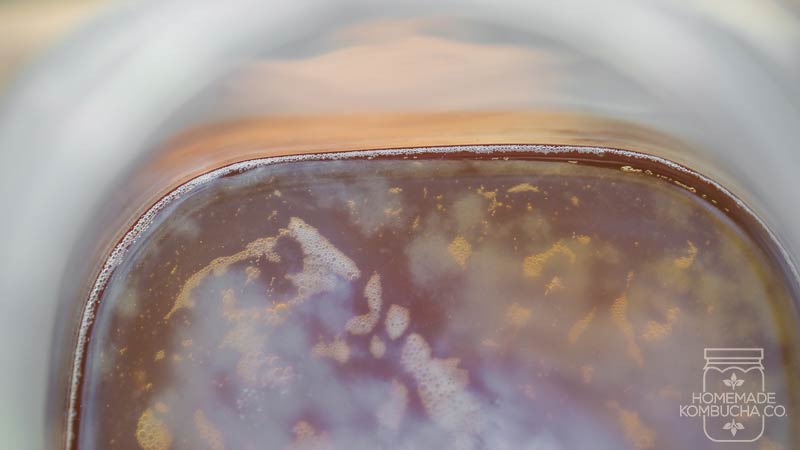
What should my culturing kombucha look like?
At first it will just look like tea, with a SCOBY floating in it and then as time progresses you will notice a thin film appearing on the surface of the liquid. This is the start of the baby SCOBY.
It is perfectly normal for ‘strings’ and ‘blobs’ to appear in the liquid – these are usually related to the yeast found in the SCOBY.
The film on the liquid surface in the photo is the baby SCOBY starting to form.
There appears to be mould on my SCOBY. Can I still use it?
No – attempting to use a contaminated SCOBY is potentially dangerous. If there is obvious mould or the brew smells bad it is contaminated and should not be used. Please dispose of the batch, sterilise all containers and utensils, and then purchase a new SCOBY to start again.
Please click on Healthy SCOBY VS Poor Quality SCOBY which is found above for more information.
Kombucha FAQs
What is kombucha?
A slightly sweet, slightly acidic fermented tea beverage. Described as tasting like something between a sparkling apple cider and champagne, it is fast becoming a popular drink amongst health conscious individuals.
Kombucha combines sweet tea mix with a SCOBY culture, to create a fermented beverage rich in organic acids, vitamin B, folate and a range of beneficial probiotics.
With experts now understanding the vital link between gut health and overall wellness, consuming fermented products like kombucha can play a key role in achieving good gut health.
Not only this, kombucha is a great tasting, refreshing beverage that can be enjoyed by the whole family.
Why brew your own Homemade Kombucha?
Brewing homemade kombucha is great fun for the whole family, and also saves you bucketloads of money. Making your own kombucha also means you are in complete control of the process – making sure that your chosen ingredients are the best quality. When you make your own kombucha you can be sure that there are no plastic chemical or metal contaminants. Your kombucha will not only be delicious – but also as healthy as possible.
Did you know:
Children love learning about kombucha – it is a great way to teach them about chemistry, biology and the importance of carefully preparing food.
After receiving my kombucha SCOBY, how long can I wait before I start my first ferment?
A SCOBY needs oxygen to survive, it should be immediately opened up from the packaging and used as soon as possible.
If you cannot make your kombucha brew straight away, it will be ok to leave the SCOBY in a clean jar with the starter liquid and a cotton cloth over the top to keep dust and insects out.
We recommend reading over Sterilise Your Brewing Jar in the instructions for further information.
How can I store my kombucha SCOBY prior to my first ferment?
If you cannot make your kombucha brew straight away, it will be ok to leave the SCOBY in a clean jar with the starter liquid and a cotton cloth over the top to keep dust and insects out.
We recommend reading over Sterilise Your Brewing Jar in the instructions for further information.
Why does a green tea SCOBY cost more than a black tea SCOBY?
Many people prefer the lighter, delicate taste of a green tea kombucha brew. However, a quality green tea SCOBY is harder to produce than a black tea SCOBY. The price of the green tea SCOBY reflects the extra effort required.
Can I use a black tea SCOBY to make a green tea kombucha or vice versa?
Normally yes, however the strains of bacteria and yeast in the SCOBY will have become acclimatised to a certain balance of nutrients found in either black or green tea.
Changing the tea base may stress the SCOBY, triggering a change in the flavour for the first batch or two. If you want to switch to a green or black tea, brew gradually by mixing in a different ratio of the teas over a few kombucha batches.
Can I use any type of tea to make my kombucha?
No, it needs to be real tea from the Camellia sinensis plant. The easiest tea to produce a quality kombucha is a organic black tea, so that no pesticide residue will interfere with the SCOBY.
For the details on which tea to use – please read through Choosing Which Tea within the instructions.
Should I use white or brown sugar to make my kombucha?
The best sugar for the health of the SCOBY is white sugar and the next best option is organic evaporated cane crystals. Brown sugar has a high molasses content which will produce a poor quality kombucha brew.
For the details on which sugar to use – please read through Choosing Which Sugar & The Likely Results within the instructions.
What equipment should I use to handle my SCOBY & how do I prepare everything?
This is very important. For the details on what equipment to use – please read Equipment within the instructions.
We also find the article What to know before starting your own Homemade Kombucha very useful for our clients.
How will I know when my kombucha brew is done?
Normally the kombucha will be ready after about two weeks if everything was done correctly. The obvious signs are a new SCOBY on the top of the liquid, a tart, acidic taste and a low pH. For more information please read through our instructions.
It has been a couple of weeks since starting my first kombucha batch. How do I know it is brewing properly?
Normally the kombucha will be ready after about two weeks if everything was done correctly. Temperature and pH levels are very important when brewing kombucha.
The obvious signs are a new SCOBY on the top of the liquid, a tart, acidic taste and a low pH.
We also find the article What to know before starting your own Homemade Kombucha very useful for our clients.
What do I do with my kombucha SCOBY once I have finished with it?
Normally people will harvest their fresh kombucha and then prepare a new batch of sweet tea to feed the SCOBY. A SCOBY will last a very long time if it is looked after properly.
Are the kombucha SCOBYs reusable?
Yes, provided they are healthy. If you follow our instructions you will be able to reuse the SCOBY many times over!
Can I add flavours while brewing my kombucha?
No – you can flavour kombucha after the first fermentation cycle is complete and the liquid has been removed from the SCOBY. The SCOBY can be contaminated and be harmed or die if you add flavouring while it is still brewing.
Once the batch is ready, harvest the kombucha and add any flavours you want.
Can I cut my kombucha SCOBY in half?
Theoretically, half of a SCOBY will still ferment the sweet tea into kombucha. However, if you are going to cut the SCOBY please do not use metal, and please avoid contaminating the SCOBY with other bacterial strains.
We also find the article What to know before starting your own Homemade Kombucha very useful for our clients.
My kombucha SCOBY has developed holes & rips in it, can I still use it?
Yes, this is a relatively common occurrence. Usually a SCOBY will get holes in it when separating the ‘mother’ and ‘baby’ SCOBY. This will not harm the SCOBY or the quality of the kombucha as long as it hasn’t been damaged by contact with metal utensils.
We also find the article What to know before starting your own Homemade Kombucha very useful for our clients.
My kombucha SCOBY is a lot bigger than my container. Does it matter?
No, the SCOBY will be fine (within reason). If you prepare your kombucha properly a new SCOBY will form on the surface that matches the size and shape of the container.
Can I drink any of the tea my SCOBY comes in?
The tea and SCOBY are not for human consumption straight out of the package.
The entire contents of the tea needs to be used for your initial brew to give your SCOBY the best chance of creating quality Kombucha. The tea inside the vacuum packaged pocket will also be very acidic on its own.
What do I do with my SCOBY if I am going away or want to take a break from brewing?
A SCOBY can survive for at least four weeks without any fresh sugar to feed the culture. Most experienced brewers will make something called a SCOBY hotel to leave their SCOBY for extended periods of time. Essentially this is a large jar, stacked with SCOBYs and a 50/50 mix of kombucha tea and fresh sweet tea. Leave the jar in a dark, cool place for the SCOBYs to slowly ferment the sweet tea.
After about six weeks it is a good idea to clean up any excess yeast strands and then replenish the sweet tea.
Can I drink kombucha while pregnant or breastfeeding?
Kombucha can contain a very low alcohol content (<1%) so we would generally recommend to avoid it whilst pregnant or breastfeeding.
Some people claim that the probiotics, organic acids and vitamins offset any potential risk caused by these very low levels of alcohol. Keep in mind this is a controversial topic, and we are not medical professionals. Instead we recommend that you consult with your doctor to see what they have to say about it.
About my order
Collapsible content
How are the kombucha SCOBYs transported?
We ship all orders across Australia by using Australia Post.
Our products are packaged into boxes, using either recycled cardboard, paper or plastics or FSC certified paper/cardboard for padding. We aim to limit our plastic waste as much as possible and encourage our customers to reuse or recycle the packaging materials.
How are the kombucha SCOBYs packaged?
To ensure no contamination of the scoby we vacuum pack them in food grade nylon pockets which are BPA free.
How long will it take to get my SCOBY?
Once we have received payment we will aim to dispatch your products between 2 and 10 working days. We only send out SCOBYs that are freshly grown – which means the delivery time will depend on when you placed your order relative to the brewing cycles.
In some cases you will receive your order in only a couple of days – we will always keep you updated of when your order is packaged and dispatched.
My order has been damaged, what can I do?
All SCOBYs and kits are insured with Australia Post.
Firstly, please take photos of the damage and email them to us as soon as you receive the order. We ask that you keep your order and packaging until we resolve the issue with Australia Post.
Once we make the claim with Australia Post, we will advise you on the process moving forward.
We ensure all of our orders are packed thoroughly with enough protection!
If you have any other questions, please contact us and we will get back to you!
